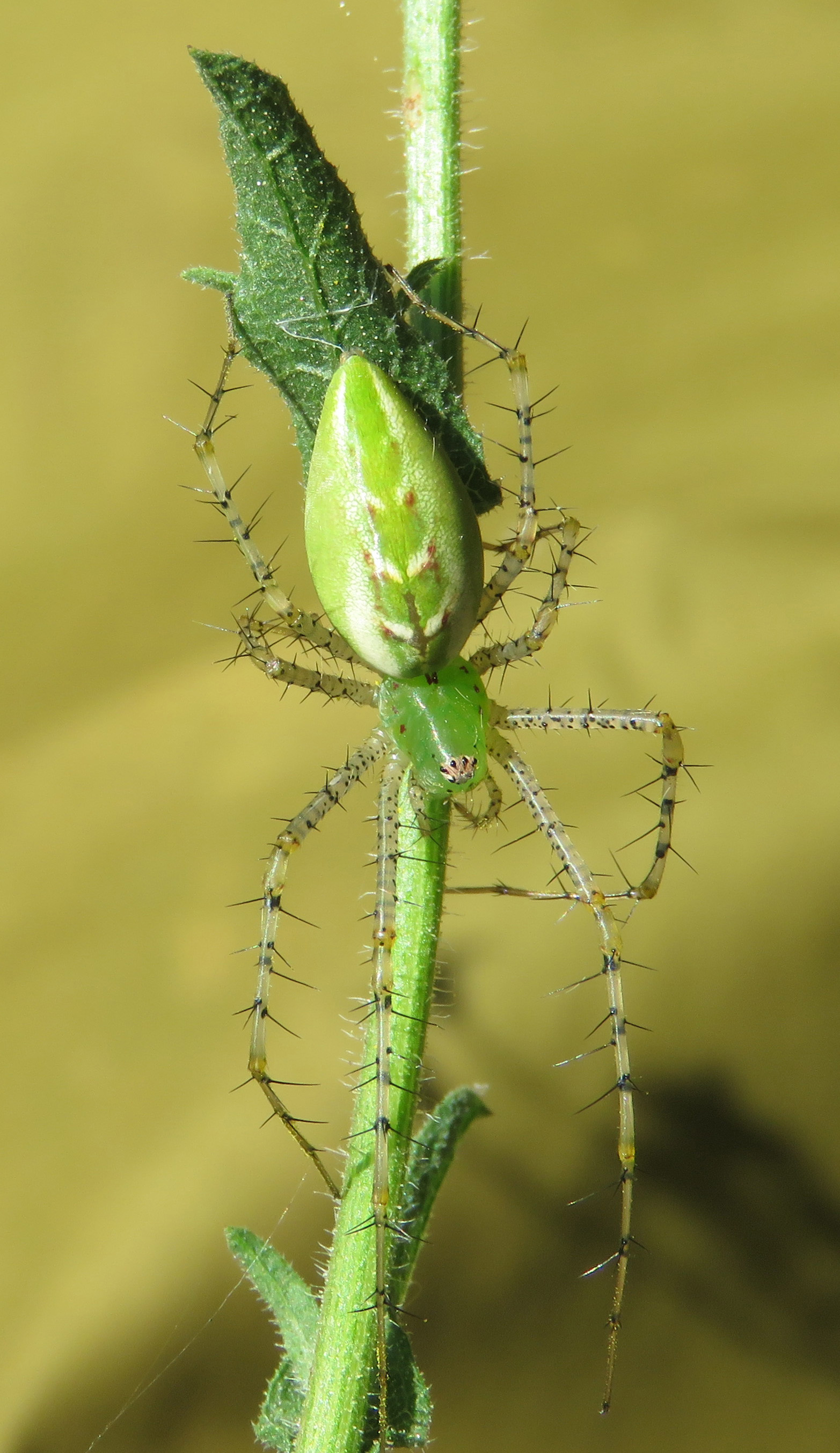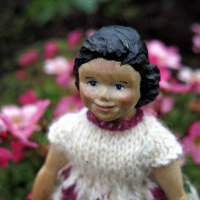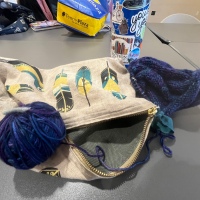Biodiversity…I Spy…Natural Dyes
Today we present! (Dun-dun-dah) Textile Ranger – Plant Detective!!!!
(It would be very helpful if you could read this in the voice of Sgt. Joe Friday from the series Dragnet.)
Here in the deep and lonely woods of East Texas, many plants produce dyes.
Some plants give gorgeous color, like this coreopsis, that produces orange — (you may be thinking, I don’t think Sgt. Friday ever said “gorgeous”, but there is no arguing with the use of that adjective for this color, so it stays) —
or these pokeberries, that give red —
But while many of these dye plants are well-known and publicized, some look for unknown dye sources.
In 2013, a humble dye novice, aided only by the books Wild Color by Jenny Dean, and Harvesting Color by Rebecca Burgess, conducted a series of dye experiments. She tried different mordants, heating methods, and post-processing treatments, searching for non-fugitive colors from native plants.
Eventually she relied on one process and one process only — Step One: prep wool ahead of time by mordanting with alum and cream of tartar (common, grocery-store chemicals), let it dry and wind it into small skeins,about 10 grams. (More details about the process are in this post.)
Step Two: fill a quart jar full of plant material, pour boiling water over the plants, drop a test skein in. Let it set in the sun all day, and cool in the dye overnight.
Step Three: Remove the skein, let it dry in the shade. Wait a week or more to rinse.
Being ignorant about plants, the dyer did the dye tests before doing time-consuming study to identify the plants. Plants that produced good color jumped to the top of the “Most Wanted!” list and were identified as quickly as possible, given the dearth of helpful nature guides and/or websites relating to Miscellaneous Pond Plants.
Two otherwise nondescript plants, dog fennel and waterleaf, yielded clear, colorfast yellow-greens. The dyer points now carries dyed yarn samples with her whenever she leads nature hikes, to alert others to the value of these “ordinary weeds”.

Dog fennel and dye sample. Dog fennel is one of those common names that is used for very different plants around the country.
Day after day the dyer ventured out in the morning, picked a couple of plants, ran dye tests, and recorded results in the evening. She began to recognize some of the plants, even when she encountered them far from their usual environments. But as the dye tests often proved disappointing – with weak colors, or maybe no color at all – she started to get sloppy on her record-keeping.
One hot July day, some lovely deep colors showed up in one of the jars.

1 and 3, mystery plant in solar jar; 2, dipped in copper after dyeing. 1a, 2a, and 3a show how those colors held up to being in direct sunlight.
Thinking she knew which plant produced the color, she thoughtlessly tossed the plant material onto the compost heap. Several days went by before she picked more of the plant for another test. But this time, no color resulted! What happened? Had she sampled the plant at a particularly dye-some moment in its life? Or had her memory played her false?! What plant had produced the bronze???
She scouted the plant’s neighborhood to see what information she could turn up:
But everything looked the same. Nothing tipped her off to which plant would produce those gorgeous bronzed tones.
There was only one thing to do: a Plant Line-up.
The possible dye producers were rounded up, brought in, and photographed. All appeared very similar. Only close study revealed the differences.
Number One has tiny purple, orchid-shaped flowers, and the growing tips look like grass seedheads. Number Two has tiny four-petaled white flowers, and just more leaves growing at the tops. Number Three – on further observation, the novice dyer recalled from two years ago that its name is waterleaf – it flowers later in summer, and it has fine but painful thorns. She realized it was not a prospect for the bronzy dye. Number Four has the largest leaves, and red shading at its joints. Based on the look of its blooms from past summers, it is believed this is primrose willow.
Two more prospects were found and brought in.
Number Five is thought to be goldenrod, based on old flower stalks found hiding in the plant. Number Six has coarse, reddish, dandelion-type leaves.
Prospects 1, 2, 4, and 5 were put through the dye test, (the dyer running low on jars at that time), and these are the results handed down.
All the plants produced a dye in the olive/ gray-green spectrum. Nothing to write home about. However, the dyer is glad to have distinguished among these very similar plants, and also glad to have tested all the prospects. The best prospect for a bronze-colored dye is Number 4, the unknown plant with the reddish joints. Further investigation will be made. AND DULY RECORDED.


























Sign me up for the pokeberry and coreopsis dyes. You didn’t say, but did you run across any plants that caused skin rashes? And, since I’ve never dyed wool, does it take dye differently than cotton? Just the facts, ma’am.
About 15 minutes after I posted, I realized that I had left out the best line! Glad you supplied it for me.
I have not found anything that causes a rash, either when I picked it or when I grabbed a little skein out of the dye. And I have knitted up the dye skeins (after rinsing them well, though) and didn’t have any problems. That is not to say that someone more sensitive than I might not have problems.
With my limited experience, I have found wool much easier to dye than cotton. With cotton, I have gotten 50 shades of brown. But maybe I just don’t know the right technique to get bright colors. This gives me a little problem, because we don’t exactly wear wool down here, so my dye skeins have gone into a notebook, and a sample scarf that I just carry when I do textile talks.
The Pokeberry is really nice. Be Blessed because you are, Mtetar
Thank you! I was just thinking about you and hoping you are well.
You’re most welcome and yes all is well thanks for the thought. Be Blessed because you are, Mtetar
Fun post but, yikes, what a mystery! You really have found some wonderful color-producing plants along the way!
Yes, some day I will get really scientific about it, and try the same plants after different times of the year, or after it rains, but so far I am just trying to figure out which plants produce color, and how long it lasts. I can see why dyers stuck to tradition – it can take years to figure out if a plant is worth using or not!
Reblogged this on justliveyourlifeokay.
From living in KY I DO know Pokeberry’s certainly can stain!! That was before my ‘wooly’ days 🙂 nice post….all I need is some SUN!!!
After months of rain we are finally getting some sun – and the sun has revealed all the cobwebs and dust that built up when it was too gloomy to see!
I’m surprised at the orange from the Coreopsis as I would have thought a golden yellow, but love the orange too. Can you just imagine how the early settlers and Indians used different grasses and berries, etc., to dye their wool and make rugs, shaws, etc. Your different test of the grasses/weeds was interesting.
If you just add a tablespoon of ammonia to the dye bath after the yarn has achieved as much yellow as you think it will get, and keep the yarn in there another few minutes, it turns orange. I have so many plants that give yellow, I thought I would use my Coreopsis to get orange. I used clear, non-sudsing ammonia. I can’t remember where I read that tip! 🙂
try the goldenrod… I’ve gotten a bronzy gold from goldenrod stems before. Colours vary from the plant depending on if you use the blooms or the stems and leaves. Also, is it possible that you might have gotten a baby willow (salix sp.) tree??? green willow bark (from branches or from volunteer baby “weed trees”) can give shades of yellows/gold-browns and might go bronze depending on your mordants. Although from the samples you posted here, I’d bet it’s the goldenrod.
Yes – thinking about how the dyes vary from the parts of the plant, I was also thinking that maybe it depended on the time of year, or the amount of rain we had had, and that possibly the pigweed had just had a good day! Once I narrow down the plants that give good lightfast color, I am going to get methodical about those kinds of conditions. Right now I just throw some plant material in a dye jar when I think about it and go on about my day.
I do have a willow tree, but I know willow, so I would have remembered that. It’s the more nondescript pond plants that are giving me trouble, sorting them out. I did try the goldenrod and didn’t get much different results than the pond plants, but I didn’t heat it, just put it in a jar in the sun. I will try it again and also try the willow!
Thanks for the tips!
Maybe my goldenrod is a different variety (I’m in Virginia) or maybe the mineral content of the soil and water affects their color potential…. I do usually bring my dye pots to a near boil or full boil, so it could be the heat that made the difference. I find most plants will try to give you just a blah yellow/tan/green unless you play with coaxing something else out of them.
Pingback: Color, Color, Color…. | Threadcrazy
The greenish tones seem unusual , is there copper or iron in water or the pot? Really nice. Didnt know if you id’d all your plants yet. #5 seems al little like a Baccahris that grows out here (dry s Calif) near stream beds. The leaf of #6 almost looks like a Mimulus but they usually have 3 veins from the base. Is intereting how its lvs clasp the stem. Do either of these have flowers? how tall are they? Recall a book on Texas dye plants from 10~ yrs ago in our library(you could request it).
No, just our well water. When I was experimenting two summers ago, I didn’t really find any difference between our well water, pond water, or distilled water
I do have a Baccharis and I got some bright yellow-green from it, but it faded pretty quickly.
I will have to look up Mimulus.
The problem I have with dye books is that they focus on proven plants, so these pond weeds are not usually featured. But I have not seen a book on just Texas plants so maybe it would have these.
Hey, it’s me, the random botanist who just found your site again. I *love* that you are experimenting with the plants around you and that you work to ID them! Here’s what I’ve got for these dudes. (I just can’t help myself!) Of course, this post is old enough that you may have already gotten them all!
1. Justicia ovata var. lanceolata (lanceleaf water-willow; synonym Justicia lanceolata. I am accustomed to seeing J. americana and not anything else. Looks like a cute species!)
2. Diodia virginiana (Virginia buttonweed)
3. Hydrolea uniflora (one-flower waterleaf; partly went off your description of it. We don’t have this where I’m from)
4. Polygonum sp. (knotweed; it looks like you might have some flowers on the piece at the bottom right…hard to see. If those are flowers then this is definitely a Polygonum and not a closely-related Persicaria. I’d have to have a closer look at it to ID it to species, either way.)
5. Solidago sp. (sure, probably a goldenrod; not even going to try to guess on a non-flowering Texas species.)
Driving me crazy because I *swear* I know what this is…but all I’m coming up with is a giant brain fart. Best stop thinking about it or I’ll be on it all night!
Thank you so much! Now that you have given me some possibilities, I will have to go pull plants and check them with online resources. I have found the Texas A & M aquaplant page but it doesn’t have very many plants, https://aquaplant.tamu.edu/plant-identification/ .
If number 1 is a water willow that would be ironic because for 2 years I have helped a little with a project where prisoners grow water willow to plant along a lake shore, and I have seen tons of those plants but never associated them with the ones I have at home. 🙂
You are definitely right about the Virginia buttonweed and I did not have an ID for that so yay! Thank you!
I am pretty sure of #3, the Hydrolea uniflora.
Number 4 I believe is a Ludwigia — looking at the USDA website tonight I found L. leptcarpa,
https://plants.usda.gov/java/largeImage?imageID=lule4_1h.jpg . I had found primrose-willow before, but all the pictures I saw showed only 4 petals on the flower and the one here has 5. The one at the USDA site has 6. So I will have to do some more homework.
Also, tonight I clicked on the picture of the 4 different species, and was reminded that there are comments there too — maybe you will find something helpful there.
I hope you hear about your own experiments!
Sorry I took so long to get back to you!
I haven’t been able to do any real experiments here yet. I finally have my soy milk to pre-treat my fibers (cotton and linen), but I don’t have good weather to dry it! It’s constantly raining here lately and it’s even humid in my house. Gross.
I realized after I posted my original comment that plant 4 was probably a Ludwigia, but I decided to honor my original brain fart and let it go. (Okay, okay; I was being lazy.)
There’s more than one species of water willow, and the one in your pictures isn’t one I’ve ever seen before. It looks different enough that you might not have recognized it if you were working with another species. The common one I’m familiar with and I have seen being grown for outplanting is Justicia americana.
There is an old published flora of Texas that I had to use at work when I was tasked with identifying a lot of decades-old Texas specimens, but I don’t have a copy of my own. It was helpful, but due to its age, limited. What I used when checking for species on your plants was an herbarium site. An herbarium is basically a special collections library for pressed plant specimens, and it’s where people like me do a lot of our work.
Many collections are in the process of being digitized for remote work. I don’t remember which portal I used to check yours (oops), but there are a number available. Some portals simultaneously search more than one institution’s collection. Here’s the first one that came up when I searched for a Texas herbarium: https://prc-symbiota.tacc.utexas.edu/collections/harvestparams.php
Most of the portals are pretty similar in how they work. When I wanted to see a list of Justicia species documented from Texas, I typed in Justicia as the genus and there was an option to look at a list. I could also directly look at the specimens and see if they fit the bill (or if they were misidentified, haha). You can also put in your county and search for all plants recorded from there. Do keep in mind that despite consisting of dead plants, herbaria are living projects…there’s SO much to verify and correct, especially with names and geographic boundaries changing over time. The larger the database you access, the more likely it is to capture the species you may have on hand, but outdated names and misidentified specimens can still abound. Oh, and just plain data glitches!
You can also look at the USDA plants site, but it’s also a work in progress!
If you have any more mystery plants that won’t budge, feel free to write me at duckytheloon [at] Gmail dot com. It’s always a treat!
Thank you for getting back to me! I am very scattershot about this whole blog as you can probably tell, but I do plan to update the natural dye page. I just did another experiment with the Virginia buttonweed and got some interesting results.
I have done soy milk with native persimmon — I literally let it sit in the pot for a year. Got a good brown color and a very crispy texture. The cloth ripped very easily though so I think I let it sit too long.
I will be in touch, eventually! 🙂